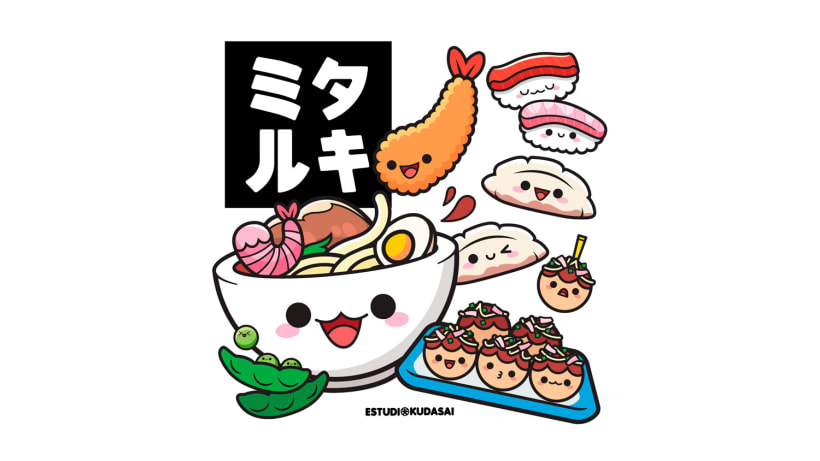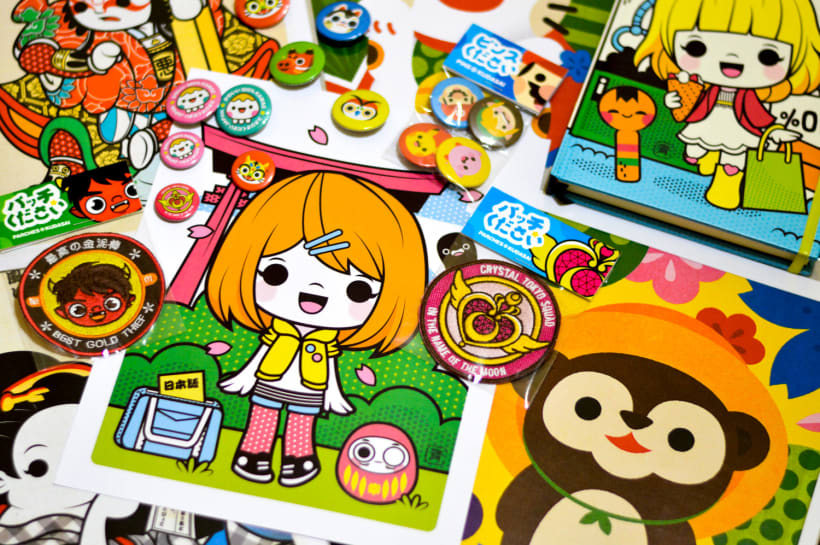Cute Japanese Things To Draw
Discover the power of cute and the secret formula behind Japanese kawaii adorable illustration characters
The concept of kawaii was born in Japan during the 60s. In just a couple of decades, this idea of "adorability" has spread to all corners of the world, attracting legions of fans. It is difficult to resist smiling at the perfectly designed features of a kawaii illustration but, what does kawaii exactly mean?
We spoke to Azul Piñeiro and Carlos Higuera, two designers and illustrators specialized in kawaii illustration and founders of Estudio Kudasai (@estudiokudasai), to learn more about the origin of this term and above all, what is the formula to create kawaii —or extremely lovable— characters.

What does kawaii mean?
Kawaii is a Japanese word that means "cute" or "adorable". It is used to describe all those things that cause a feeling of tenderness just by seeing or experiencing them.
However, there is no such thing as a "cute illustration" or "adorable illustration" genre in Japan. The name kawaii for an illustration style is something that was invented in the West, and usually refers to the illustration of characters that generate tenderness and sympathy, but at the same time share specific formal standards, such as large heads, chubby bodies, round eyes, etc.

It is a simple categorization within illustration, closely associated with the Japanese visual aesthetic. It has to do with the use of characters for branding that is well established in that country. The Japanese use characters for their brands and licenses, of course, but also for traffic announcements, awareness campaigns, entities, events, or prefectures. Even the police have their own characters. And this use of characters is not associated with something childish; it is intended for all audiences.
The character and the feeling it inspires in us is used as a communication tool, and a very effective one at that! Although they exist in a vast universe, we can notice certain common elements in all of these characters, something that makes us immediately bond with them.

What is the first known kawaii example?
Without a doubt, that will be Hello Kitty. Not for being the first example of a character created in this style, but for being some sort of an ambassador of it.
Hello Kitty is the poster child of character licensing worldwide and has established many of the parameters that are considered the pillars of the kawaii style: simplicity, a limited color palette, round shapes, and a characteristic expression. Anyone can recognize her just by looking at her bow. Today, Hello Kitty is still the most successful licensed character, almost 45 years after its creation.
What does a character need to have to be considered kawaii?
The perception of what is kawaii and what is not can be very subjective. Some people get this feeling of tenderness upon seeing a baby, for example, and some people do not. However, when we talk about illustration, there are certain details that make us recognize a character as kawaii at first glance.
The facial expression is one of them. There are certain standards in the way the eyes are drawn, for example, like dots or little black circles with sparlkes.. The alignment of eyes, nose, and mouth is another one. The closer they are to a horizontal line that crosses the face, the more tender our character will look. The idea of horizontality and centralization is closely associated with our perception of what we consider adorable, and is present in babies or puppies.

The eyes and nose are usually located more towards the center of our face at an early age, and the eyes tend to be larger in proportion. As we grow, they separate and adjust to the proportions of an adult face. That is why when we see a character with big eyes, a small mouth, and everything very close together, it gives us that kawaii effect we are looking for.
Another important factor is simplification: the use of limited resources, without excessive details, and a very simple color palette. It is about expressing a lot with little. Sometimes our characters may not have fingers, even a nose, but through their gaze and their pose, we express what is happening to them.
And as the last tip: the more compact, small, and chubby the character looks, the more tenderness it will inspire. That never fails.

How did you start designing kawaii characters?
We are both lovers of Japanese culture since we were little. We both received cultural stimuli from Japan, from all sorts of sources: food, animated series, music, toys, video games, etc. As adults, we were interested in design and illustration for children and youth, and we drew inspiration from our personal tastes, influenced by the characters of the Japanese brands that we liked. It was something that happened progressively but, one day, we said to ourselves: hey, this thing we do is called kawaii!
We love designing mascots; it is what we like to do the most. As the mascot is usually a communication tool between a brand and the client, creating that link in the kawaii style is often infallible!

What is the most difficult job you ever faced?
Quite often, clients interested in the kawaii style contact us because "it is fashionable." It may be true. It has increased in popularity in Latin America, among both boys and girls. But, as we move forward with the proposals, the complaints start: "That looks very Japanese,""Can we make it look less childish?", "His eyes look strange, like holes."
Our goal is to develop a kawaii-corporate style, but we believe that the kawaii style is still not well known, that still sounds alien, and it is difficult to get some clients to trust us in that regard.
Luckily we have many other clients who have fully trusted our work and experience and have been happy with their kawaii-style mascot.

Which ones do you remember fondly?
This question is very difficult to answer. We put a lot of love and commitment into our projects, and they are all like our children. The ones that involve characters, or the design of mascots, are, without a doubt, the ones we have more affection towards.
There is a project that is already a few years old that involved the design of a mascot for a ramen restaurant in Taiwan. Today we see it, and there are many things that we would change, but it was the first time that the character was made as a costume to promote the place and applied to a variety of products. People were taking pictures with it. When the character transcends the screen and enters the 3D world to interact with its audience, that's where we feel the happiest.

Cute Japanese Things To Draw
Source: https://www.domestika.org/en/blog/3392-what-is-kawaii-art-japan-s-culture-of-cuteness
Posted by: mclaughlinfragend.blogspot.com

0 Response to "Cute Japanese Things To Draw"
Post a Comment